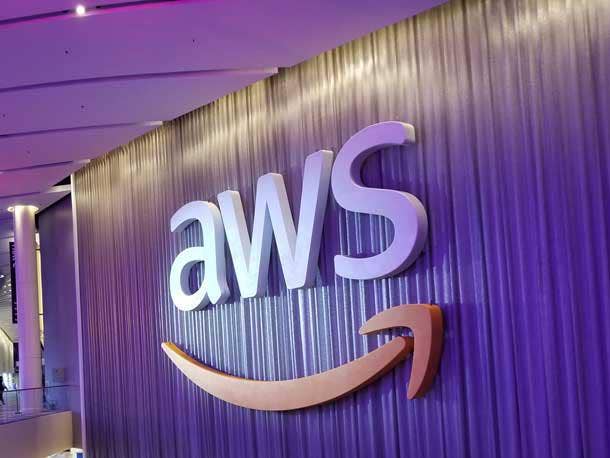AWS Q3 Earnings Preview: From Sales Growth, AI To Microsoft
AWS will report its Q3 2023 earnings results tomorrow. From sales growth predictions to Microsoft reports, here are five big things to watch.

The largest cloud company in the world will unveil the results of its Q3 2023 financial earnings tomorrow as Amazon Web Services strives to keep its cloud market leadership position and advance its artificial intelligence charge.
The cloud unit of Seattle-based Amazon is currently on an $85 billion run rate with a focus in 2023 on AI, specifically generative AI. AWS is the primary driver of Amazon’s bottom line with an operating margin of nearly 25 percent in the last 12 months.
Did total sales growth from AWS stabilize in third quarter 2023? What generative AI wins will AWS report tomorrow? Will Amazon executives like CEO Andy Jassy comment on his company reportedly spending $1 billion on Microsoft cloud products?
CRN breaks down the key areas that investors, channel partners and customers need to watch for.
[Related: AWS Marketplace Partner Report: Margins, ROI And Benefits]
AWS Q3 Earnings Estimate: $23.19 Billion
The Zacks consensus estimate for Q3 2023 is that AWS will report total sales of $23.19 billion for the quarter that ended on September 30. This would represent a roughly 13 percent revenue increase year over year.
“We note that the growing popularity and strong adoption of AWS have been aiding Amazon in generating high margins from the cloud business,” said analysts at Zacks Investment Research in a blog post. “The trend is expected to have continued in the yet-to-be-reported quarter.
AWS is the worldwide market share leader in cloud computing. As of Q2 2023, the company owned approximately 32 percent of the global cloud infrastructure services market, followed by Microsoft at 22 percent share, then Google Cloud at 11 percent share, according to market data from Synergy Research Group.
This year, AWS—as well as its two largest competitors Google and Microsoft—has turned its innovation and investment sights on generative AI. The company has launched a slew of new products and services around GenAI, while also forming new AI partnerships and channel programs to drive sales.
Amazon will report AWS’ financial earnings results of its third quarter 2023 on Thursday at 5:30 p.m. ET.
Here are the five most important areas to watch for during Amazon and AWS’ third quarter 2023 earnings results on Oct. 26 as well as the recent results of Microsoft and Google Cloud’s quarterly earnings.

Will AWS’ Sales Growth Rate Remain Stable?
Years ago, AWS’ quarterly growth rate percentage was constantly over 30 percent. However, as the company grew sales by billions of dollars each quarter and competition from the likes of Google Cloud and Microsoft Azure intensified, AWS sales growth rate began to lower in 2022.
Here’s the key AWS sales figures for the past four quarters:
In Q3 2022, AWS sales increased 27 percent year over year to $20.5 billion.
In Q4 2022, AWS revenue grew 20 percent year over year to $21.4 billion.
In Q1 2023, AWS sales increased 16 percent year over year to $21.4 billion.
In Q2 2023, AWS revenue increase 12 percent year over year to $22.1 billion.
The Zacks Consensus sales estimate for AWS in Q3 2023 is $23.19 billion. This would represent a 13 percent revenue increase year over year.
“We believe that an expanding customer base and a strong discount offering for long-term deals are likely to have driven AWS’ top line in the quarter under review,” said analysts at Zacks Consensus in a blog post.
The Takeaway: If Zacks’ 13 percent sales growth prediction for AWS is accurate, this means the company’s sales growth will have finally stabilized. Although a 13 percent year over year sales increase is less than half of what AWS witnessed just one year ago during Q3 2022, it will prove that AWS is still the dominant global market leader in cloud computing.

AWS’ Big Generative AI Revenue Drivers? Andy Jassy Comments Will Be Key
For the past few quarters, Amazon and AWS are keen to report to the public new AI innovation, customer wins and big partnerships it generated during the quarter.
One of the biggest questions with the AI phenomenon in 2023 is just how much of a money-making opportunity it is as AI can be costly or difficult to realize business outcomes. It will be important to note what Amazon CEO Andy Jassy, who was previously CEO of AWS, says about AI as it relates to sales and customer stickiness.
“AWS has continued to add to its meaningful leadership position in the cloud with a slew of generative AI releases that make it much easier and more cost-effective for companies to train and run models (Trainium and Inferentia chips), customize Large Language Models to build generative AI applications and agents (Bedrock), and write code much more efficiently with CodeWhisperer,” said Jassy during AWS most recent Q2 2023 earnings report.
The Takeaway: It will be interesting to see if AWS showcases AI customer wins and ties it to sales growth or profitability. Many believe GenAI can improve efficiency, productivity and more, but big revenue gains tied to AI has been somewhat inconclusive. Jassy will hopefully shed some light on how Amazon’s billion in AI investments are paying off.

Big Newsworthy Discussions: Amazon Reportedly Spending $1 Billion On Microsoft And $4 Billion Investment In Anthropic
Two of the most newsworthy events over the past month will hopefully be brought up by either analysts asking questions during Amazon’s earnings call on Thursday or by executives themselves.
It was reported last week that Amazon has committed more than $1 billion over five years to secure more than 1 million Microsoft 365 license users. These seats will be used by corporate employees and works in frontline roles, according to reports.
Microsoft is AWS’ biggest cloud competitor. Amazon does have its own collaboration tools such as its videoconferencing offering Chime and its content collaboration and storage service WorkDocs. Amazon typically doesn’t give its competitors a $1 billion check or put large workloads on a competitor’s cloud infrastructure.
The Takeaway: It will be a blockbuster if Amazon confirms it is spending a large amount of money on Microsoft cloud products for its own employees versus using its own collaboration products. This could lead to a slowdown of internal investment in its own collaboration cloud portfolio.

Amazon’s $4 Billion Commitment To AI Startup Anthropic
Another newsworthy discussion hopefully discussed during Amazon’s Q3 2023 earnings call tomorrow: Amazon’s plans to invest up to $4 billion in startup Anthropic, a top competitor of Microsoft-backed OpenAI.
Last month, Amazon unveiled a minority stake investment in Anthropic as part of a strategic agreement with the San Francisco-based two-year-old startup who was founded by former OpenAI executives.
Anthropic committed to uses AWS’ chips to build, train and deploy future AI foundation models on, while also co-innovating alongside Amazon.
However, this month it was reported that Anthropic is also seeking to raise $2 billion in new funding with Google expected to be part of the investment. Google and Microsoft are arguably Amazon’s two largest AI rivals in the world as all three are betting heavily on AI.
The Takeaway: It would be great for channel partners and customers to hear more about Amazon’s long-term strategic roadmap for Anthropic and just how bullish Amazon is to partner with the startup.

How AWS Will Stack Up Against Google Cloud And Microsoft
AWS’ two biggest cloud and AI rivals are Google Cloud and Microsoft, which both reported their quarterly earnings results this week.
Google Cloud reported Q3 2023 revenue of $8.4 billion, up 22 percent year over year. It wasn’t as strong growth compared to Q2 2023 when Google Cloud sales increased 28 percent year over year.
This week, Microsoft reported financial results for calendar year Q2, with Microsoft’s Intelligent Cloud unit generating total sales of $24.3 billion, up 19 percent year over year. For calendar year Q1, Microsoft Intelligent Cloud unit generated $24 billion in revenue, representing an increase of 15 percent year over year.
Microsoft does not provide Azure sales figures. The company includes Azure sales alongside server products and other cloud services in its Intelligent Cloud business unit.
The Takeaway: Google Cloud reported 22 percent sales growth year over year, while Microsoft reported 19 percent sales growth. It will be key to see if AWS’ growth rate is on par with its two largest cloud competitors.